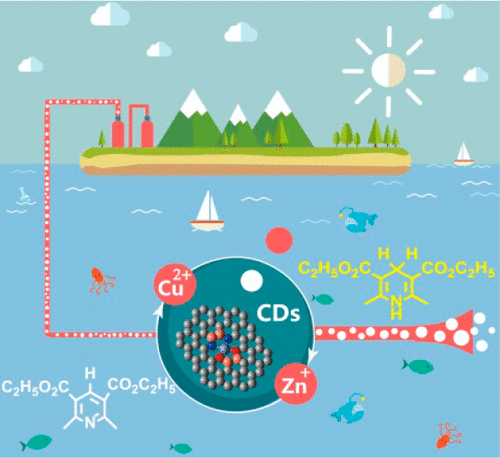当前位置:
X-MOL 学术
›
ACS Catal.
›
论文详情
Our official English website, www.x-mol.net, welcomes your
feedback! (Note: you will need to create a separate account there.)
Synergies between Unsaturated Zn/Cu Doping Sites in Carbon Dots Provide New Pathways for Photocatalytic Oxidation
ACS Catalysis ( IF 11.3 ) Pub Date : 2017-12-27 00:00:00 , DOI: 10.1021/acscatal.7b03423 Wenting Wu 1, 2 , Qinggang Zhang 1 , Ruiqin Wang 1 , Yufei Zhao 3 , Zhongtao Li 1 , Hui Ning 1 , Qingshan Zhao 1 , Gary P. Wiederrecht 2 , Jieshan Qiu 4 , Mingbo Wu 1
ACS Catalysis ( IF 11.3 ) Pub Date : 2017-12-27 00:00:00 , DOI: 10.1021/acscatal.7b03423 Wenting Wu 1, 2 , Qinggang Zhang 1 , Ruiqin Wang 1 , Yufei Zhao 3 , Zhongtao Li 1 , Hui Ning 1 , Qingshan Zhao 1 , Gary P. Wiederrecht 2 , Jieshan Qiu 4 , Mingbo Wu 1
Affiliation

|
Unsaturated metal species (UMS) confined in nanomaterials play important roles for electron transfer in a wide range of catalytic reactions. However, the limited fabrication methods of UMS restrict their wider catalytic applications. Here, we report on the synergy of unsaturated Zn and Cu dopants confined in carbon dots (ZnCu-CDs) to produce enhanced electron transfer and photooxidation processes in the doped CDs. The Zn/Cu species chelate with the carbon matrix mainly through Cu–O(N)–Zn–O(N)–Cu complexes. Within this structure, Cu2+ acts as a mild oxidizer that facilely increases the unsaturated Zn content and also precisely tunes the unsaturated Zn valence state to Znd+, where d is between 1 and 2, instead of Zn0. With the help of UMS, electron-transfer pathways are produced, enhancing both the electron-donating (7.0 times) and -accepting (5.3 times) abilities relative to conventional CDs. Because of these synergistic effects, the photocatalytic efficiency of CDs in photooxidation reactions is shown to improve more than 5-fold.
中文翻译:

碳点中不饱和锌/铜掺杂位点之间的协同作用为光催化氧化提供了新途径
限制在纳米材料中的不饱和金属物质(UMS)在广泛的催化反应中对电子转移起着重要作用。但是,UMS有限的制造方法限制了其更广泛的催化应用。在这里,我们报道了限制在碳点(ZnCu-CDs)中的不饱和Zn和Cu掺杂剂的协同作用,以在掺杂的CD中产生增强的电子转移和光氧化过程。Zn / Cu物种主要通过Cu–O(N)–Zn–O(N)–Cu络合物与碳基质螯合。在此结构中,Cu 2+用作温和的氧化剂,可轻松增加不饱和锌的含量,并将不饱和锌的价态精确地调整为Zn d +,其中d在1和2之间,而不是Zn 0。在UMS的帮助下,产生了电子转移途径,相对于传统的CD,增强了给电子能力(7.0倍)和受电子能力(5.3倍)。由于这些协同作用,显示CD在光氧化反应中的光催化效率提高了5倍以上。
更新日期:2017-12-27
中文翻译:

碳点中不饱和锌/铜掺杂位点之间的协同作用为光催化氧化提供了新途径
限制在纳米材料中的不饱和金属物质(UMS)在广泛的催化反应中对电子转移起着重要作用。但是,UMS有限的制造方法限制了其更广泛的催化应用。在这里,我们报道了限制在碳点(ZnCu-CDs)中的不饱和Zn和Cu掺杂剂的协同作用,以在掺杂的CD中产生增强的电子转移和光氧化过程。Zn / Cu物种主要通过Cu–O(N)–Zn–O(N)–Cu络合物与碳基质螯合。在此结构中,Cu 2+用作温和的氧化剂,可轻松增加不饱和锌的含量,并将不饱和锌的价态精确地调整为Zn d +,其中d在1和2之间,而不是Zn 0。在UMS的帮助下,产生了电子转移途径,相对于传统的CD,增强了给电子能力(7.0倍)和受电子能力(5.3倍)。由于这些协同作用,显示CD在光氧化反应中的光催化效率提高了5倍以上。











































 京公网安备 11010802027423号
京公网安备 11010802027423号